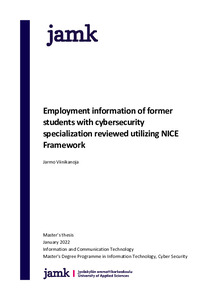Employment information of former students with cybersecurity specialization reviewed utilizing NICE Framework
Viinikanoja, Jarmo (2022)
Viinikanoja, Jarmo
2022
Julkaisun pysyvä osoite on
https://urn.fi/URN:NBN:fi:amk-202201251650
https://urn.fi/URN:NBN:fi:amk-202201251650
Tiivistelmä
The specialization option for cyber security was added to the Information and Communication Technology (ICT) studies at JAMK University of Applied Sciences in 2015. This research aimed to find out where the former students of JAMK University of Applied Sciences, who graduated from Bachelor's Degree Programme in Information and Communication Technology with Cyber security specialization have been employed.
The main objective was to research which of the NICE Framework Work Roles best describe their work. The research used mixed methods, and the analysis was conducted with a survey and a comparison of the results with the data gained from previous research and publications.
The results included information about the size, sector, and industry type of organizations where the former students are employed. The results seemed to support previous research: the need from working life does not match with the current education. Hence, the results can be used to adjust the cybersecurity education to better match the working life needs in the future.
The findings indicate that it would be easier to compare courses to existing frameworks if the courses contained information about the types of categories, knowledge, skills, or abilities which are taught at JAMK University of Applied Sciences. Additionally, a survey made for this research could be used in future information gathering from graduated students, and this would provide valuable knowledge about the skills
needed in the constantly changing field of cyber security.
The main objective was to research which of the NICE Framework Work Roles best describe their work. The research used mixed methods, and the analysis was conducted with a survey and a comparison of the results with the data gained from previous research and publications.
The results included information about the size, sector, and industry type of organizations where the former students are employed. The results seemed to support previous research: the need from working life does not match with the current education. Hence, the results can be used to adjust the cybersecurity education to better match the working life needs in the future.
The findings indicate that it would be easier to compare courses to existing frameworks if the courses contained information about the types of categories, knowledge, skills, or abilities which are taught at JAMK University of Applied Sciences. Additionally, a survey made for this research could be used in future information gathering from graduated students, and this would provide valuable knowledge about the skills
needed in the constantly changing field of cyber security.
